The MTC is the complete monitoring solution. Source and loudspeaker selection, mono, dim and mute switching functions, talkback with built-in talkback microphone up to the creation of a headphone mix for the artist.
Inputs
The MTC offers six stereo inputs. The Musician input should preferably contain the musician’s signal, so that this signal is also available at the Musician control in the Cue Mix section.
The Mix input is then intended for the DAW’s master output. Musician and Mix and 2TrA and 2TrB are balanced input stages.
A mono signal should always be fed into the left channel to be heard on both channels in the phantom center.
2Tr C and 2Tr D are unbalanced and have RCA connectors. HiFi equipment can also be connected here.
All inputs are additive! The MTC mixes all input signals together.
The slave out stereo output always carries out the selected input signal(s) (except Musician) unprocessed. Among other things, metering can be connected here.
Cue Mix
As an individual mix of Musician signal and Mix signal, an analog, latency-free Cue Mix can be created for the musician.
For each of the three artist statements: “I can’t hear myself”, “The mix is too loud” and “I can’t hear anything”, there is a dedicated control as an answer.
At the back, the Cue Mix can be sent to a headphone amplifier in the vocal booth.
Talkback
A built-in electret microphone is available for talkback communication, which can either be activated with the Talk button or remotely controlled via a foot switch.
The level control sets the correct level for the microphone signal.
At the Talk Out output only the talkback microphone signal is send out via a balanced jack socket.
The sound engineer can thus speak directly to the speakers or musicians via an active loudspeaker placed in the recording room.
Control Room
Three pairs of loudspeakers can also be operated in parallel on the MTC.
The volume is controlled by an analog potentiometer and a 45mm full aluminium knob.
With the Source Blend control an optimal monitor mix can be created quickly.
The headphone output can be used to listen in parallel to the selected speaker pair.
The headphones are switched on or off with the HP On switch, so that they can remain plugged in even if they are to be muted.
Specifications
Analog inputs & outputs: XLR & TRS Jack (balanced), RCA:
- Maximum input gain (XLR, Jack): 21 dBu
- Maximum input gain (RCA): 19 dBu
- Input impedance (Jack): 50 kΩ
- Input impedance (RCA): 10 kΩ
- Output impedance (XLR): 100 Ω
- Common mode rejection (1 kHz): 70 dB
- Frequency range (-3 dB): 10 Hz – 100 kHz
- THD +N (10 Hz – 22 kHz, 0 dBu): 0.005 %
- Noise (A-weighted): -89.4 dBu
- Dynamic range (XLR, Jack): 110.4 dB
- Dynamic range (RCA): 108.4 dB
Internal Linear Power Supply with Toroidal Transformer:
- Operating voltage for analog audio: +/- 15 V
- Operating voltage for relays and LEDs: +12 V
Mains Power Supply:
- Mains voltage (selectable): 230 V AC / 50; 115 V AC / 60 Hz
- Fuse for 230 V: T 315 mA
- Fuse for 115 V: T 630 mA
- Power consumption: max. 10 W
Dimensions & Weight:
- W x H x D (width x height x depth): 272 x 91 x 220 mm
- Unit weight: 2.3 kg
- Shipping weight (incl. packaging): 4.4 kg
 2 Years Warranty
2 Years Warranty 2 Years Warranty
2 Years Warranty



















